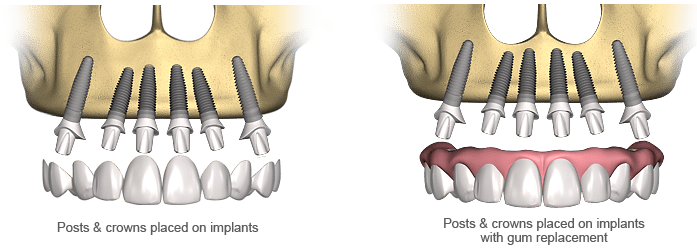Overdenture
Click on video below to learn about Hybrid Denture treatment presented by Dr. Hendriks
An overdenture is an economical and functional way to replace loose fitting dentures or make an easy and natural transition to dentures. An overdenture is a removable denture prosthetic device that replaces a complete arch of teeth. With an overdenture, two or more implants are placed in bone in the upper or lower jaw and a denture with a snap-like attachment is inserted over the implants and “snaps” tightly into place.
The reason for an overdenture solution weighs on the individual and their dental needs. Reasons for an overdenture solution could be because the patient has had a lot of oral health treatment and may have multiple missing teeth or is in poor oral health and needs a prosthetic to correct their dental health and lifestyle. An overdenture is very comfortable and functionally allows the individual to enjoy eating and smiling without the embarrassment of having the denture move or fall out in social settings, unlike a traditional denture.
The upper and lower jaw have different bone densities and requires different amounts of implants to be placed for attachment and stability. The most common and recommended overdenture treatment is to have four implants placed in the arch of the jaw. This allows for equal forces to be balanced on the implants and the function of the denture and implants provide optimal results for the individual. Implants in the jaw bone help to maintain bone level and avoid atrophy or loss of the facial structure, while providing a stable base for chewing food and speaking naturally.
The procedure for an overdenture begins with a series of records taken at our office and a pre-surgical visit. The pre-surgical visit includes a thorough review of the patients medical history, treatment needs are discussed and tailored to the patient, surgery instructions are presented, consent forms and payment may be exchanged at this time as well. The next visit is often surgery.
At surgery, the beginning phase of treatment is started. Usually this includes the extraction of the remaining teeth and the placement of bone augmentation and implants. Usually a temporary denture is placed the day of surgery. At the time of the extraction is the preferred placement for dental implants, although, it is not necessary and implants can be placed sometime after the individual has had teeth removed. There are circumstances that implants are not placed at the time of the first surgery. These decisions are all based on the individual and their health and what the doctor sees as most appropriate for the patient. After implants are placed, the healing phase begins.
The healing phase ranges from 3-6 months in most cases. The healing time will depend on the procedures completed and the individual’s overall health and compliance with the doctor’s recommendations for post-surgery care. The doctor will see the patient for some post-operative visit to monitor the patient’s healing progress. When the doctor feels the implants are stable and integrated completely the final prosthetic process will begin.
The prosthetic process is the final phase in which the patients final denture is custom designed and fitted for attachment. A series of aesthetic try in dentures will be constructed and the patient will try them in until they approve of the overall look and fit of the denture before sending to be processed. Once approved by the patient and the final prosthetic is complete, the patient will return to the office for an uncovering of the implants and attachment of the prosthetic denture.
This completes the overdenture treatment process and the denture may be enjoyed by the individual, eating and smiling comfortably.

Overdenture Procedure
If you want to avoid dentures, full arch dental implants are a great alternative. Full arch dental implants do require bone grafting in the majority of cases, and they may not be an option for all patients. We will conduct a complete oral health history to determine if you are a candidate for full arch dental implants. Some patients use implant retained dentures as they allow the patient to have two implants that are used as anchor or support teeth and keep the dentures from moving. Dentures are supported by ball and o-rings, small bars with clips, or clips that will snap onto the implant.

Two Implant Overdenture
Full arch dental implants will use two or more implants to support dental implant fixtures. The fixtures lightly touch the gums, allowing them to hold dentures in place, but keeps them from hitting the gums. The reason why full arch dental implants are valuable is because there is less bone atrophy and more stability for the dentures. Removable options like this are popular because they are less expensive and easy to maintain. Watch the video below to learn more.
Non-Removable Dental Implant Prosthetics Procedure
For a full arch tooth replacement with dental implants, you will need to look at the different options that are available and which one will provide the best result. Using bone grafting can provide assistance with areas that have bone loss and we can use additional pink areas on the denture to fill in areas where the gums have receded. The result will provide an aesthetically pleasing appearance and offers the patient a chance to have a full-functioning set of teeth once again.




